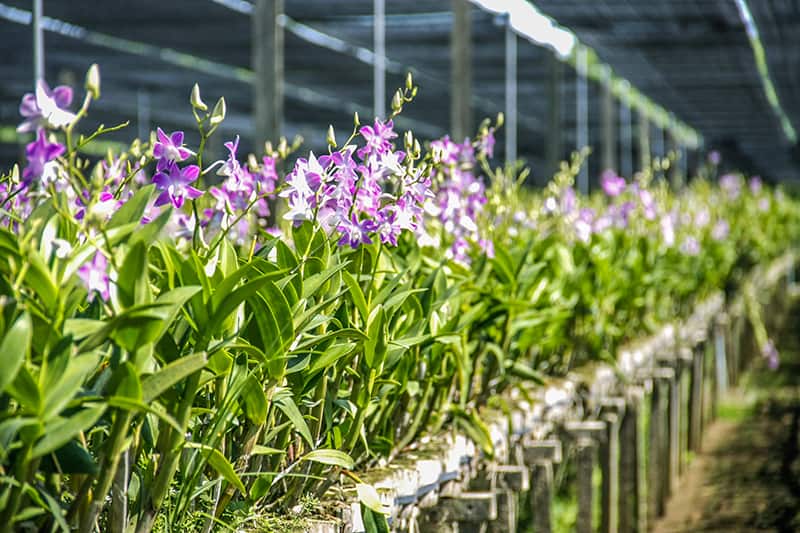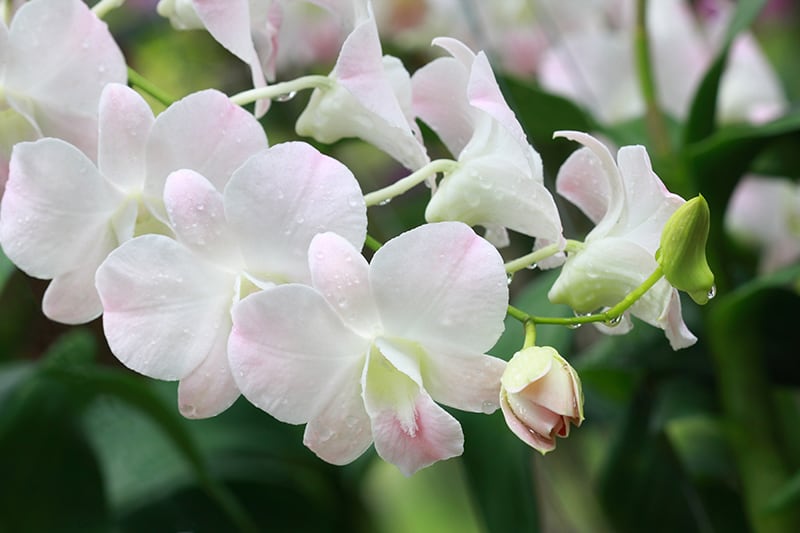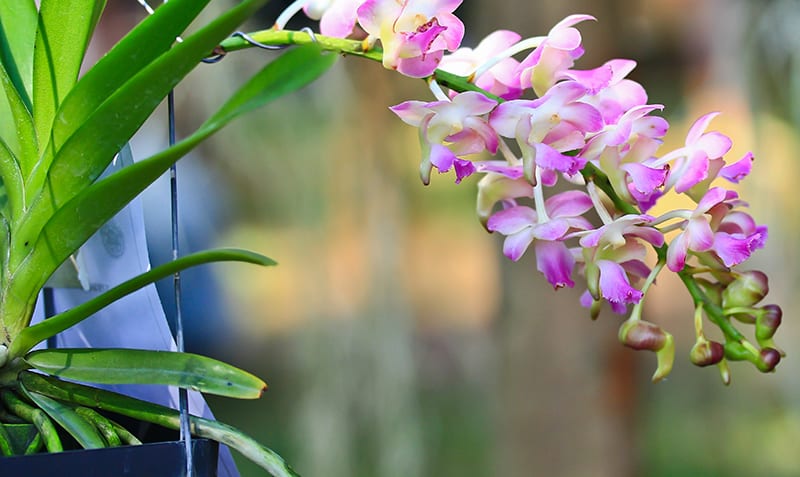How Long Does It Take for a Dormant Orchid to Bloom Again
Orchids are common houseplants because they are beautiful and usually fairly cheap. People typically buy easy-to-bloom orchid types, or orchids while they are flowering, and when you take them dwelling, their stunning blooms tin can last many weeks or even months. Once the flowers have, yous may be tempted to discard the plant, but orchids are actually very like shooting fish in a barrel to rebloom, and if you learn how to care for them to encourage this, then they can exist very long-lived plants that will reward you with fresh new flowers every year.
Afterwards-Bloom Care
After an orchid has reached the end of its flowering catamenia, the blooms will fall from the constitute, leaving the leaves and flowering spikes intact. These flowering spikes, if healthy, volition produce new flowers, so don't cut them off. The all-time thing you lot tin can do at this point is to cut the flowering spike dorsum to the next node, as this will encourage the plant to put its energy into re-blooming. In the outcome that the flowering spike dies, then you should cut it back to the base of operations. You will know information technology is dying if information technology turns to the colour of straw.
After blooming, the orchid will enter a period of dormancy. It won't make any visible growth, and instead, information technology will be resting and storing up its energy to use subsequently. During a plant'south dormant phase, you would normally refrain from feeding information technology, merely this is not true for orchids. While in dormancy, your orchid will need to replace all of the nutrients it used up during its flowering phase.
To help with this, feed your orchid with a balanced fertilizer, ideally 20-twenty-xx. This should be done every few weeks. The fallow menses tin final every bit long as nine months, so do non be discouraged if your orchid is seemingly very tiresome to rebloom. While it rests, movement information technology to a room that is slightly cooler than the rest of the house, such as a rarely used room like a spare bedroom.
Ideally, a dormant orchid should be in temperatures between 55 and 65°F. It should be kept in constant indirect sunlight until a new flower spike emerges, or the previous flower spike has new growth. When the flower spike reaches around five inches in peak, it should be secured to a spike for support. Not long after the fasten has exhibited growth, new flower buds should sally. If your spikes practice not produce flowers afterward several months of new growth, then this can indicate a problem with the plant'southward position, and you should move it to a different room to see if that helps.
Orchids can be very temperamental when information technology comes to lighting and temperature requirements, and information technology may take some trial and error to discover a spot it is happy in, simply once your establish successfully reblooms, yous volition have more cute flowers that stay in bloom for up to ii months, and yous volition know exactly how to get your orchid to rebloom next time.
Too Much Calorie-free

If you want your orchid to rebloom, and so it should exist in consistent indirect calorie-free. Direct calorie-free tin can cause obvious problems such equally foliage scorching, but too much sun is likewise a common cause of preventing an orchid from reblooming. Surprisingly, artificial light can even inhibit an orchid's ability to rebloom. This is because shorter days and longer periods of darkness are one of the key things that point to an orchid that information technology is time to prepare for reblooming.
If your orchid is kept in a commonly used room in your home where lights are kept on into the evening, then the constitute can miss its natural cue to rebloom. This is why during an orchid'southward dormant period, it is all-time to keep it in a lesser used room in the dwelling, or at least one that is non lit up during the naturally darker evenings. By assuasive the orchid to keep its natural circadian rhythm, y'all volition be helping to ensure it is prepared to rebloom.
Not Enough Low-cal
While as well much light is a problem for an orchid, not enough low-cal tin can also crusade similar results when it comes to trouble reblooming. Orchids are most commonly kept in a window, ideally, an east or west-facing window where they will go plenty of brilliant simply indirect light. If you lot don't accept a suitable windowsill, or you merely want to continue your orchid somewhere you will enjoy it the most, such every bit past the side of your bed or as a centerpiece on a dining table, then you might demand to invest in a grow low-cal.
If your orchid does not get plentiful light during daytime hours, so it will certainly struggle to rebloom, but a grow light can really help in these situations, providing artificial light where natural light isn't possible. Set your grow calorie-free on a timer and then that information technology will turn off at the appropriate time of day; otherwise, you will terminate up with the opposite trouble of besides much light.
Too Much H2o

Overwatering is the chief cause of death and refuse among houseplants, and orchids are especially susceptible to this because their roots need to dry out between waterings. If your orchid is failing to rebloom and y'all are unsure if you have been watering information technology correctly, then the lack of new flowers could exist an indication that the plant is nigh to die.
If an orchid does produce buds, but the buds then fail to open or fall from the plant, then this is a primal sign that the plant is not being watered appropriately. The all-time way to resolve an overwatering issue is to repot the orchid, removing every bit much of the soggy soil as possible and replacing information technology with a fresh and dry orchid soil mix.
There are plenty of means you tin ensure that your orchid is watered correctly in the future, and you tin avoid overwatering. Using the right type of growing material for your orchid is the all-time place to starting time. Pre-mixed orchid soils have a high content of bark, which allows water to flow through the soil very quickly while also retaining a small-scale amount of moisture most to the plant's roots. This is an platonic type of soil mix for an orchid, but you can too make your own orchid soil mix, ensuring that it is very well-draining.
Many types of orchid plant pots are transparent, and they have holes around the edges. This is because acceptable airflow is vital to proceed an orchid'due south roots healthy, and the transparent pot ways you lot tin go on an centre on the roots and spot any potential problems before they go troublesome. You lot can apply the clear pot to keep a check on when you should next water your plant.
Roots that are a fresh green colour do non demand to be watered, but when the light-green starts to fade, then this is an indication that the plant is ready to receive some more wet. Just as with other houseplants, you should ever ensure that your orchid pot has drainage holes in the base and so that any excess water tin can easily flow away from the soil, and this should then be emptied away.
Keep an centre on the saucer or decorative pot your orchid is positioned in because resting in the drained water volition make the establish's roots constantly moisture, which will quickly cause the demise of an orchid. If you lot apply the right type of growing medium for an orchid and always dispose of excess water subsequently watering the institute, and then information technology volition be very unlikely that your orchid becomes overwatered.
Likewise Fiddling H2o
Too picayune water will typically not impale an orchid as quickly every bit overwatering will kill it, but it certainly can prevent the institute from reblooming. If an orchid does not have admission to enough moisture to sustain its growth, and so it will direct all of its bachelor energy towards keeping the existing parts of the plant alive, such as the leafage, every bit opposed to putting energy into producing new flowers. In the event that the orchid has produced buds, these could dry out and fall from the plant if the orchid is underwater because the plant volition blot the moisture from the buds and redirect it elsewhere.
If you're worried about overwatering, it tin can be natural to accidentally go too far in the opposite direction and unintentionally cause your plant to die of thirst, but effort to remember that an orchid'due south native habitat is in the rainforest where they volition be subjected to frequent showers. While yous should allow an orchid's roots to dry out out between watering, don't exit them dry out for long because the constitute is not tolerant of drought, and reblooming will certainly be inhibited.
Inadequate Feeding
Orchids are not typically heavy feeders, simply they do demand to replenish their nutrients during their dormant stage in order to rebloom. If your soil mix is organic, then fertilizer isn't essential, but a sterile inorganic soil mix can mean that an orchid has no access to nutrients, and information technology volition struggle to proceeds the energy to rebloom in this state of affairs. Employ a counterbalanced fertilizer during the orchid'south dormancy, and you lot should soon find that your orchid starts to produce buds.
Needs Repotting
Figuring out when an orchid needs repotting tin can exist tricky business because while some orchids enjoy existence rootbound, others require plenty of root space in order to rebloom. The best communication you could follow to decide whether to repot your orchid is to pay attention to the roots of the found rather than the foliage. In order to do this finer, you should exist growing your orchid in a transparent pot.
Orchids need their soil mix to be quite chunky because as well as ensuring that it drains well, this also helps to ensure good airflow around the roots. Orchid soil, similar whatever other soil, will break down over time. When it breaks downwards, and the mesomorphic pieces become small particles, so the orchid needs to exist repotted. If the soil resembles ordinary soil rather than an orchid soil mix, and then once again, yous should repot your orchid. This is because small particles of soil will suffocate the roots, and they need ventilation in order to keep the orchid healthy and promote reblooming.
Unfortunately, some orchids resent being moved and will refuse to bloom for upwardly to a year subsequently repotting, but this is an essential part of orchid care, and without repotting, it may never bloom once more at all. Another sign that you should repot your orchid is if several roots start to pitter-patter over the top of the pot, as this indicates that in that location is no room bachelor in the pot.
Temperature Issues

Orchids are tropical plants that enjoy warm environments, merely in order to rebloom, they need to feel a temperature drop. This temperature alter is a cue for the establish that information technology is time to rebloom. At that place are two ways to reach this; either motion your plant to a lesser used room in your home or move your orchid to a unlike room each night.
If you have a room in your home that is cooler than the rest, such as a basement or a spare bedroom, move your orchid to this room to spend the dark, every night, for two weeks. You're aiming to ensure the plant experiences around a 10-degree drop in temperature each night. Alternatively, if your dwelling house is heated during the day, turn the heating off overnight, and this will permit your plant to experience the necessary temperature drop. This volition help to promote reblooming.
Though orchids do need a temperature change to produce flowers, take care not to put it in a room that is too cold, considering orchids are sensitive plants that volition not react well to this. They should not be kept in temperatures lower than fifty° F and should not be moved outside.
Source: https://www.trees.com/gardening-and-landscaping/how-to-rebloom-orchids
0 Response to "How Long Does It Take for a Dormant Orchid to Bloom Again"
Post a Comment